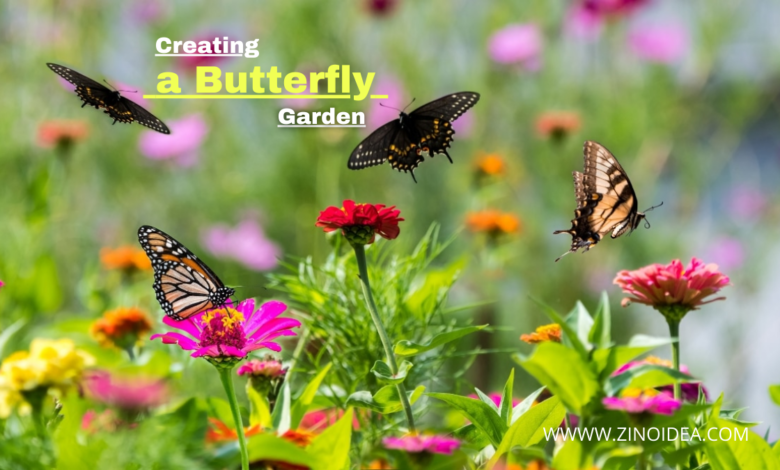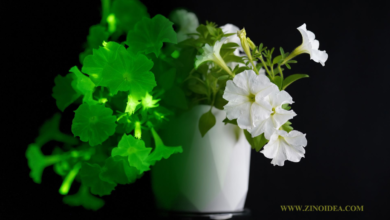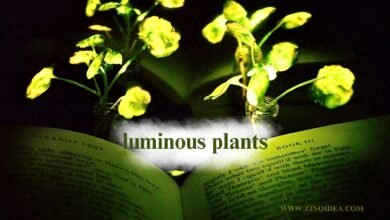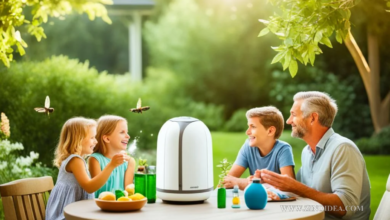Creating a Butterfly Garden: A Step-by-Step Guide

Ever thought about turning your backyard into a place where butterflies love to visit? Creating a butterfly garden is a great way to make your outdoor space more beautiful and eco-friendly. It’s a chance to connect with nature and enjoy the beauty of butterflies up close.
But starting can seem daunting. That’s why we’ve put together this guide. We’ll walk you through the key steps to make a butterfly garden. From picking the perfect spot to choosing the right plants and providing what butterflies need, we’ve got you covered.
Key Takeaways
- Understand the importance of butterflies and the benefits of a butterfly garden
- Learn how to choose the right location for your butterfly garden
- Discover the best host plants for caterpillars and nectar plants for adult butterflies
- Explore composting methods to enrich your garden soil and support a healthy ecosystem
- Uncover tips for planting and arranging your butterfly garden for maximum appeal
Introduction to Butterfly Gardening

Butterflies are amazing creatures that are key to our ecosystem’s health. By making a butterfly garden, you help these beautiful insects and support their numbers. We’ll look at why butterflies are important and how a garden can help. It attracts wildlife, boosts pollination, and makes your outdoor area more beautiful.
Why Butterflies Matter
Butterflies are pollinators, crucial for many plants to reproduce. They move pollen from flower to flower, helping plants make fruits and seeds. This is vital for our natural world’s health and variety. Plus, they feed birds, bats, and other animals, making them a big part of the food chain.
Benefits of a Butterfly Garden
- Attracts many butterflies and other pollinators, like bees and hummingbirds
- Makes your outdoor space look better with bright colors and butterfly movements
- Helps with biodiversity by offering homes and food for various wildlife
- Boosts pollination, which means more fruits and seeds in your garden
- Creates a peaceful spot for you to enjoy nature’s beauty
Adding how to start composting, composting for beginners, indoor composting, and outdoor composting to your garden helps your space. It doesn’t matter if you have a small balcony or a big backyard. Making a place for butterflies is fulfilling and meaningful.
Choosing the Right Location
Choosing the right spot for a butterfly garden is crucial for its success. You need to think about several important factors for the best environment for butterflies.
First, pick a place that gets a lot of sunlight all day. Butterflies love the sun and need it to keep warm and fly. Try to find a spot with at least six hours of direct sunlight, even better if it’s more.
- Make sure the area is safe from strong winds, as butterflies can’t fly well in windy conditions. Look for a spot that’s protected by trees, shrubs, or fences.
- Being close to water, like a birdbath or a shallow pond, is key for butterflies. They need water to stay hydrated.
Adding composting methods and bins to your garden helps the ecosystem. Composting makes the soil rich in nutrients and attracts beneficial insects, including butterflies. This creates a great place for butterflies to live.

“The location of your butterfly garden is the foundation upon which a thriving butterfly habitat is built.”
To make a butterfly garden successful, you need sun, shelter, and water, and composting to enrich the soil. With these things, you’ll create a beautiful place for butterflies to visit.
Selecting Butterfly-Friendly Plants
To make a butterfly garden, start by picking the right plants. You need plants that caterpillars can eat and flowers that adult butterflies love. This mix gives butterflies what they need to live well in your garden.
Host Plants for Caterpillars
Caterpillars need certain plants to eat and lay their eggs. These plants are vital for the next generation of butterflies. Some good ones are milkweed, dill, fennel, and parsley. Planting these ensures caterpillars have food and shelter as they grow.
Nectar Plants for Adult Butterflies
Adult butterflies eat nectar to fly and live. Pick flowers that bloom at different times for a steady nectar supply. Zinnias, lantana, and butterfly bush are great choices. These plants will draw many butterflies to your garden.
Adding composting materials to your garden is also smart. Compost feeds the soil and keeps it moist, helping your garden grow. Using composting makes your garden better for butterflies and everything else.
| Host Plants for Caterpillars | Nectar Plants for Adult Butterflies |
|---|---|
| Milkweed Dill Fennel Parsley | Zinnias Lantana Butterfly bush |
“A diverse garden that includes both host plants and nectar-rich flowers is the key to attracting and supporting a thriving butterfly population.”
Preparing the Garden Bed
Getting your soil ready is key to a successful butterfly garden. It helps plants grow well and attracts many butterfly species. We’ll look at how to prepare soil and the perks of composting for your garden.
Soil Preparation
Your garden’s soil health affects how well butterfly-friendly plants do. First, check the soil’s condition. You want it to be well-draining and full of nutrients for different plants. If your soil lacks organic matter or drains poorly, add compost to make it better.
Composting Methods
Composting turns waste into a great soil booster for your garden. You can pick from many composting ways, based on what you have. Think about using an indoor worm composter or an outdoor pile to make compost rich in nutrients. Choose a method and follow the best practices for good composting.
Preparing your garden bed well and using compost sets the stage for your plants to thrive. With the right composting tips, your butterfly garden will start strong.
Planting and Arranging Your Garden
Now that your garden bed is ready, it’s time to plant and arrange your butterfly-friendly garden. Think about bloom times, plant heights, and colors when placing your plants. This will make your garden look great and work well.
Start by adding host plants that caterpillars need for food and shelter. Think about using milkweed, fennel, and dill. Place these plants around your garden so caterpillars always have food as they grow.
Next, add nectar-rich flowers to feed adult butterflies. Choose plants like zinnias, lantana, and butterfly bushes that bloom at different times. This way, there’s always nectar available for the butterflies.
When arranging your plants, think about their heights and how they grow. Put taller plants in the back and shorter ones in the front. This creates a nice layered look. Also, group plants with similar colors together to make your garden look better.
Finally, use composting to help your garden grow strong and healthy. Compost adds nutrients to the soil, helping your plants grow and attracting more butterflies.

By planning and arranging your garden carefully, you’ll make a beautiful place for butterflies. Remember, the key is to pick the right plants, think about how they grow, and use sustainable gardening methods.
how to make a butterfly garden
Creating a butterfly garden is a fun project that turns your outdoor space into a haven for these beautiful creatures. You’ll need to focus on a few key things: picking the right plants, preparing the garden bed, and using composting methods.
Start by choosing a mix of plants that cater to different stages of the butterfly life cycle. Native plants are best because they fit well with the local environment and help native butterflies the most.
- Get the garden bed ready by loosening the soil and adding rich compost. Composting enriches the soil and helps your butterfly garden thrive. You can use a composting bin or try different composting methods, like hot or cold composting, to make great soil.
- After preparing the bed, plant your butterfly-friendly plants. Arrange them nicely so they look good and bloom all season. This ensures adult butterflies always have nectar.
By following these steps and using the right composting materials, you can make a beautiful butterfly garden. This garden will draw in many different butterflies and help your local ecosystem.
| Composting Methods | Composting Bins | Composting Materials |
|---|---|---|
| Hot Composting | Tumbler Bins | Fruit and Vegetable Scraps |
| Cold Composting | Stationary Bins | Shredded Paper |
| Vermicomposting | DIY Bins | Leaves and Grass Clippings |

“Butterflies are flying flowers, and flowers are stationary butterflies.” – Onitsuka Chikara
Providing Water and Shelter
Creating a butterfly garden is more than just picking the right plants. Butterflies also need water and safe places to live. We’ll look at how to make butterfly puddling areas and butterfly houses. These help the health and variety of your how to make a butterfly garden.
Butterfly Puddling Areas
Butterflies need moisture to get fluids and minerals. By making composting benefits puddling areas, you can draw them in. These spots, with moist sand, gravel, or a small birdbath, become busy places in your garden.
Butterfly Houses and Shelters
Butterflies also need places to rest, mate, and survive the winter. Building composting process butterfly houses or using natural shelters helps. These spots protect them from predators and bad weather. They also help your garden’s composting tips biodiversity.
| Feature | Benefit |
|---|---|
| Butterfly Puddling Areas | Provide butterflies with a consistent source of moisture and essential minerals |
| Butterfly Houses and Shelters | Offer butterflies a safe haven for resting, mating, and overwintering |
Adding these to your how to make a butterfly garden makes your garden welcoming and sustainable. It supports the local butterfly population.

Maintaining Your Butterfly Garden
Keeping a butterfly garden alive and well needs regular care. Here are key tips to help your garden stay vibrant and support butterflies:
Watering and Pruning
Watering your butterfly plants right is key. Don’t over-water or let the soil dry out. Prune plants to keep them looking good and growing well. This brings in more butterflies.
Weed Management
It’s important to remove weeds often. This stops them from taking over your garden. Pull weeds by the roots to stop them from coming back. Mulching helps keep weeds away too.
Composting for Nutrient-Rich Soil
Adding compost to your garden is a smart move. It feeds the soil and helps your butterfly plants grow strong. Both indoor composting and outdoor composting are good for your garden.
By following these tips, your butterfly garden will stay a great place for these beautiful creatures. It will keep attracting a wide variety of butterflies for many years.

“A garden is a grand teacher. It teaches patience and careful watchfulness; it teaches industry and thrift; above all it teaches entire trust.” – Gertrude Jekyll
Creating a butterfly garden is a great way to help these important pollinators and make your outdoor area more beautiful. This guide shows you how to design and keep a garden that gives butterflies food, shelter, and resources. Adding composting to your garden helps make the soil better and supports the garden’s health and sustainability.
Composting is key to a successful butterfly garden. It turns organic waste into food for the soil, which attracts many beneficial insects, including butterflies. By using composting methods like a compost bin or pile, your garden gets nutrient-rich soil. This helps plants grow well and supports butterflies.
Composting in a butterfly garden has many benefits. It makes the soil better and more fertile, cuts down on waste, and helps create a sustainable environment. Adding composting to your garden care routine helps your outdoor space stay healthy. This ensures butterflies and other pollinators can keep thriving for many years.
FAQ
What are the benefits of composting for a butterfly garden?
Composting is great for a butterfly garden. It makes the soil richer with nutrients. It also helps the soil drain better and supports the garden’s health and diversity.
Compost is a natural food source for insects and microorganisms. These are crucial for butterflies.
What are some of the best materials to compost for a butterfly garden?
Great materials for composting include leaves, grass clippings, shredded paper, and vegetable and fruit scraps. But, don’t add meat, dairy, or oils. These can bring pests and upset the compost balance.
How do I set up a composting system for my butterfly garden?
You can use different composting methods, like outdoor piles or indoor systems. Pick one that suits your space and how much time you can spend on it. Make sure it has good air flow, the right moisture, and a mix of carbon and nitrogen materials.
What are the best plants to include in a butterfly garden?
Choose native, nectar-rich flowers and host plants for caterpillars for your garden. Good options include milkweed, butterfly bush, coneflowers, and lantana. Adding these plants and a composting system will make a great home for butterflies.
How can I attract more butterflies to my garden?
To attract more butterflies, plant a mix of nectar-rich and host plants. Also, have a shallow bird bath or a butterfly puddling area for water. Using composting to enrich the soil will also help draw in more butterflies.
How do I maintain a butterfly garden over time?
Keeping a butterfly garden healthy means regular care. Weed, prune, and deadhead plants, and add compost and mulch as needed. Avoid pesticides and herbicides to protect butterflies and other good insects.



